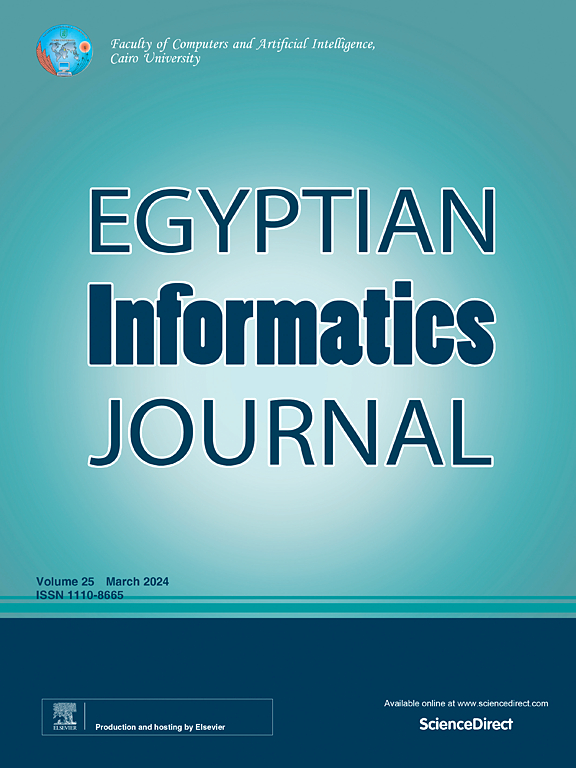基于深度学习和扩散渗透模型的网络安全威胁深度虚假检测方法
IF 4.3
3区 计算机科学
Q1 COMPUTER SCIENCE, ARTIFICIAL INTELLIGENCE
引用次数: 0
摘要
数字图像篡改领域的进步导致深度伪造技术的广泛采用,给数字取证和网络安全领域带来了明显的障碍。本文提出了一种新颖的方法,该方法结合了用于图像过滤的混合各向异性扩散-变分渗透,用于分割和边缘检测的U-Net,以及用于深度假检测的可分离卷积分类的混合图卷积网络(GCN)。混合过滤技术提高了图像保真度,同时保留了关键细节,促进了识别改变区域所必需的准确分割和边缘检测。GCN框架利用面向图形的学习来提取复杂的特征,并通过有效的可分离卷积来对真假图像进行精确分类。建议的方法使用广泛的数据集进行评估,与传统技术相比,在检测深度假图像方面表现出优越的性能。除了技术进步,这项研究还强调了深度虚假检测在网络安全方面的广泛影响。深度造假擅长欺骗自动系统和人类感知,带来了巨大的风险,包括错误信息、身份盗窃、金融欺骗和国家安全漏洞。高效的检测技术,如这里概述的,在减轻这些危险和维护数字信任和完整性方面发挥着至关重要的作用。拟议的方法定位于更广泛的网络安全框架内,强调了其在打击与深度虚假技术相关的不断升级的威胁和犯罪方面的重要性。它强调了技术进步,同时强调了强大的识别机制在应对数字变化带来的网络安全挑战方面的重要性。实验结果表明,该技术优于其他深度假图像检测器,在本研究使用的数据集上达到了99.71%的准确率。本文章由计算机程序翻译,如有差异,请以英文原文为准。
A deep fake detection approach for cyber security threat based on deep learning and diffusion-osmosis model
Advancements in the realm of digital image alteration have resulted in the widespread adoption of deep fake technology, presenting notable obstacles to the field of digital forensics and cyber security. This article suggests an original methodology that combines hybrid anisotropic diffusion-variational osmosis for image filtration, U-Net for segmentation and edge detection, and a hybrid graph convolutional network (GCN) employing separable convolution for categorization in deep fake detection. The amalgamated filtration technique improves image fidelity while conserving crucial particulars, facilitating accurate segmenting and edge detection essential for recognizing altered areas. The GCN framework utilizes graph-oriented learning to extract intricate features, supported by effective separable convolutions for precise categorization of genuine and fake images. The suggested approach is assessed using extensive datasets, showcasing superior performance in detecting deep fake images compared to conventional techniques. Besides technological advancements, this study highlights the broader repercussions of deep fake detection in cyber security. Deep fakes, adept at duping automated systems and human perception, present substantial risks encompassing misinformation, identity theft, financial deception, and breaches in national security. Efficient detection techniques, such as those outlined here, play a crucial role in mitigating these dangers and upholding digital trust and integrity. The proposed methodology is positioned within the wider framework of cyber security, accentuating its significance in combating the escalating threats and offenses linked to deep fake technology. It accentuates the technical progressions while emphasizing the vital necessity of robust identification mechanisms in tackling cyber security challenges arising from digital alterations. The empirical results illustrate that the suggested technique outperforms other deep fake image detectors and achieves a remarkable accuracy rate of 99.71% in the dataset utilized in this study.
求助全文
通过发布文献求助,成功后即可免费获取论文全文。
去求助
来源期刊

Egyptian Informatics Journal
Decision Sciences-Management Science and Operations Research
CiteScore
11.10
自引率
1.90%
发文量
59
审稿时长
110 days
期刊介绍:
The Egyptian Informatics Journal is published by the Faculty of Computers and Artificial Intelligence, Cairo University. This Journal provides a forum for the state-of-the-art research and development in the fields of computing, including computer sciences, information technologies, information systems, operations research and decision support. Innovative and not-previously-published work in subjects covered by the Journal is encouraged to be submitted, whether from academic, research or commercial sources.
 求助内容:
求助内容: 应助结果提醒方式:
应助结果提醒方式:


